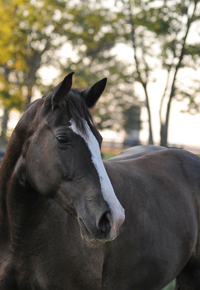One of the biggest complaints I hear from fellow Quadrupeds is that their Humans don’t feed them properly. Indeed, in my experience, this is biggest area of mis-education among people. They have very strange ideas about what makes appropriate foodstuffs for horses (i.e., giving me beet pulp while shrieking, “Not my peanut butter sandwich!” when I grab the treat they clearly brought for me), how much of it to deliver to the stall, and how to present it.
It’s not their fault. As we all know, they come to the barn with minimal education, largely gleaned from plastic ponies—both of which give you terrible preparation for the extensive needs of a live horse. Especially a live horse like me.
Teaching the Human to feed you appropriately is one of the most important lessons you will ever give them. Proper nutritional input and high energy levels (read: soooo much molasses) help you open the doors to all the other things you can teach them, like sitting the trot with no stirrups or scrubbing poo out of horsehair. You can’t show them these things if you’re weak from hunger. It’s like expecting an elementary school teacher to face a room full of sugared-up third graders without coffee—cruel and unusual working conditions.
• Preparation is key. Learn to recognize the sound of your Human’s vehicle. The moment it appears in the barnyard, begin kicking your bedding around to make it appear you have been spinning around the stall in a starved panic. Greet the Biped with a symphony composed of rhythmic rattling of the feed tub, scraping of your hooves on the stall mats, or grinding the water buckets against the wall.
• You’ve got a voice. Use it! The Humans in my barn tend to spend too much time gabbing and not enough time delivering buckets. I’ve found that bellowing at the top of my voice, especially two to three words into their sentence will make it nearly impossible to carry on a conversation. The key with this strategy, and the place where many Quadrupeds slack, is to be relentless. Screaming loudly once or twice isn’t enough. You must whinny until you get exactly what you are requesting. Being the squeaky wheel in the barn aisle will get you attention, but screaming bloody murder will get you pretty much anything you want.
• Seriously, don’t underestimate the power of screaming. If you are very lucky, you may encounter special circumstances which make your bellow even more powerful. If fellow boarders have babies who may nap while their Bipeds ride, I’ve learned people will give you just about anything to keep your mouth full. This also works well if anyone in your barn is hung over after a wild night at the grand prix. You can spot them by their dazed expression and unsteady gait. Identify your mark, warm up your pipes and channel your soprano.
ADVERTISEMENT
• Every new Human is a potential waiter/waitress.We all know Humans shortchange us when measuring out the grain, and we have to make up the calories somewhere. That’s why every time I see a Human who has been on feeding duty before, I restart my solo operetta. If they mistakenly think I haven’t had dinner and give me a second one, I’ll take it. If you employ this strategy, I suggest scarfing down Second Dinner as quickly as possible before anyone wises up.
• Proper food presentation is key. Some Quadrupeds prefer their food to be poured on the ground and will happily overturn feed tubs to put it there. Not me. I like to have my food in an elevated tub, because that makes it easier to sort. I also prefer any “supplements” or “medications” to be separated into little piles for easy removal. Lift piles of pills or undesirable larger pellets out and deposit them on the stall mats. If the Human doesn’t get the point, transfer them to your water buckets.
• Perform quality checks. I am so undernourished that I often neglect this, but it’s critical to check on your hay quality. Humans are prone to changing suppliers without providing written notice, which is rude. From time to time, you should pull apart flakes of hay to examine color, texture, dust level, and plant species. Dunk it in water to see what a hydrated version looks like. Check on absorbency by pinning some in the corner of your stall and peeing on it.
• Hold out if things get nasty. Most supplements don’t actually taste bad, but they’re your best opportunity to bring more flavor into your life. If you can convincingly pretend their presence in your grain is so horrifying it kills your appetite, your Biped’s blood pressure will increase almost instantly. People are almost as sensitive as horses when it comes to whether the feed tub is clean at the end of the night. It won’t take long before they’ll mix the new powder with applesauce, molasses or crushed peppermints. That’s worth holding out for a half a meal, right?
 |
Jitterbug is a Michigan-bred Professional Draft Cross who skillfully avoided saddles until age 5. Since then, she has been lauded for her talent in successfully managing humans while training herself to one day achieve eventing greatness. Jitter and her human live in central Kentucky. Read all of Jitter’s COTH columns. Follow Jitterbug on Facebook! Photo by Dark Horse Photography. |















